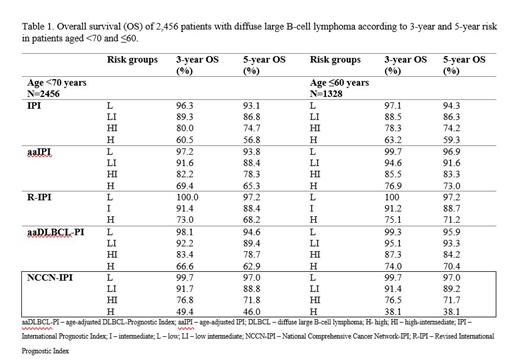Background: In diffuse large B-cell lymphoma (DLBCL), the International Prognostic Index (IPI) and age-adjusted IPI (aaIPI) remain the primary prognostic tool for outcome predictions and risk stratification in clinical trials. Several prognostic indices with the same five risk factors included in the IPI have been developed for DLBCL patients, including Revised IPI (R-IPI) and National Comprehensive Cancer Network IPI (NCCN-IPI), showing a decreased prognostic value of the IPI. Additionally, an age-adjusted DLBCL-Prognostic Index (aaDLBCL-PI) developed in patients younger than years combining similar variables (excluding age and stage), but with the addition of albumin, showed better accuracy than the IPI. Younger patients without comorbidities and a history of cancer are typically candidates for clinical trials, but validation studies of prognostic indices in this population are mostly lacking.
Aim: This study aimed to compare five clinical models (IPI, aaIPI, R-IPI, NCCN-IPI, and aaDLBCL-PI) in patients with DLBCL younger than 70 years identified from the Danish Lymphoma Registry (LYFO).
Methods: Patients diagnosed between 2000 and 2021 and identified through the LYFO were included if they fulfilled the following criteria: 1) newly diagnosed DLBCL; 2) age <70 years; 3) treated with at least one cycle of immunochemotherapy (R-CHOP/R-CHOP-like); 4) availability of all parameters for calculation of all five prognostic models; and 5) no previous/concomitant malignancy (excluding non-melanoma skin cancer). Patients with isolated central nervous system lymphoma were excluded. Discriminatory ability was calculated using the concordance index (c-index), with 1 indicating perfect discrimination and 0.5 indicating random guess. Model fitness was compared with the Akaike Information Criterion (AIC), with the lower values indicating a better fit of a model and the difference ≥10 between models indicating a significant improvement in model fitness.
Results: Of 3,184 DLBCL patients younger than 70 years, 2,456 had all parameters available for calculating five prognostic models and were included in the final analysis. The median age at diagnosis was 59 years (range 18-69) with a slight male predominance (n=1,440, 58.6%). Most patients (n=1,619, 65.9%) had advanced (III/IV) stage of disease and were in good performance status 0-1 (n=2,165, 88.2%). More than one extranodal localization was diagnosed in 738 patients (30%), and more than half of our population (n=1,462, 59%) had elevated LDH levels. All models stratified patients into four risk groups except R-IPI, which provided three risk groups. The proportion of patients allocated to the low-risk group according to the IPI, aaIPI, R-IPI, aaDLBCL-PI, and NCCN-IPI were 32.9%, 19.7%, 12.3%, 17.4%, and 15.3%, respectively. The lowest proportion of patients in the high-risk group was identified by NCCN-IPI (6.3%), followed by IPI (14.8%), aaIPI (20.2%), aaDLBCL-PI (22.0%), and R-IPI (40.7%), respectively. The median follow-up was 78.1 months (range 0.2-244 months). As presented in Table 1, NCCN-IPI produced the highest absolute 3- and 5-year difference between high and low-risk groups and was the only model with less than 50% of surviving patients in the high-risk groups in respective survival time points. Moreover, the highest c-index was calculated for NCCN-IPI (0.709), followed by IPI (0.703), aaDLBCL-PI (0.692), R-IPI (0.679), and aaIPI (0.667). NCCN-IPI showed a statistically significant difference in discriminatory ability compared to all models except IPI. The lowest AIC was found in NCCN-IPI (9,231), along with IPI (9,295), aaDLBCL-PI (9,369), R-IPI (9,310), and aaIPI (9,408). When patients aged ≤60 were selected (n=1,328), NCCN-IPI again produced the highest absolute 3- and 5-year difference between high and low-risk groups. Moreover, NCCN-IPI had the highest c-index and lowest AIC (0.758; 3,068) compared to IPI (0.742; 3,118), aaIPI (0.730; 3,124), R-IPI (0.729; 3,109), and aaDLBCL-PI (0.751; 3,110).
Conclusion: In this retrospective population-based study investigating 2,456 patients with DLBCL 18-69 years of age, we found NCCN-IPI superior to IPI and, in particular, aaIPI and R-IPI. Therefore, we suggest reporting NCCN-IPI and IPI for risk stratification in future studies and clinical trials.
Disclosures
Clausen:Roche: Other: Travel funding; Janssen: Consultancy, Other: advisory; Aztrazenica: Other: advisory; Genmab: Consultancy, Other: advisory; Abbvie: Consultancy, Other: advisory; Gilead: Consultancy; Incyte: Consultancy. Brown:Roche: Other: Advisory Board; Gilead: Other: Advisory Board. Stauffer Larsen:Roche: Consultancy; Novartis: Consultancy; Gilead: Consultancy; BMS: Consultancy.


This feature is available to Subscribers Only
Sign In or Create an Account Close Modal